Brain breaks are a powerful and effective way to address self-regulation needs, help with attention, and impact learning in the classroom. Brain breaks are movement breaks! They are movement opportunities that enable all of us to re-group and re-focus. Learning can be exhaustive to our kids. They are struggling through the day’s activities while sometimes striving to pay attention through sensory processing issues or executive functioning needs.
Brain break activities, or movement breaks can be used as part of a sensory diet or in a whole-classroom activity between classroom tasks. Here are all of the brain break resources here on The OT Toolbox. Whether you need a quick brain break, ideas to add movement to the classroom, or a scheduled sensory diet of regulating tools on hand, you’ll find many brain breaks here!
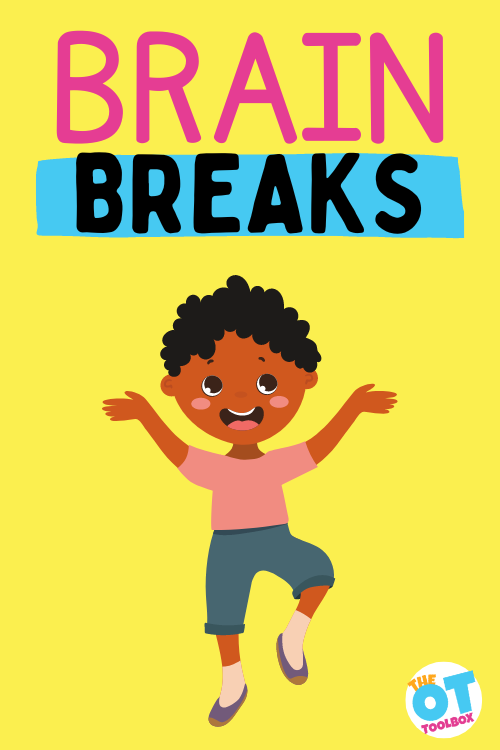
Movement Breaks or Brain Breaks?
Maybe we should consider the term movement breaks.
There have been studies done on the effectiveness of movement breaks. Specifically, one study showed that increasing movement in students increases engagement in learning. It’s thought that then information retention improves as well Marzano (2012).
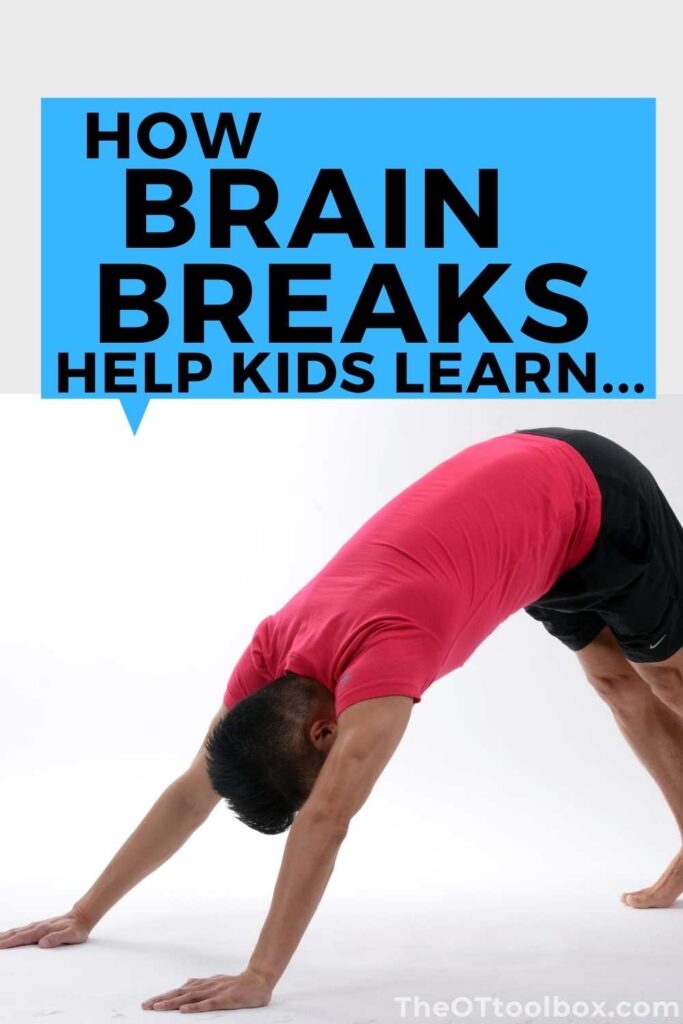
What happens during a brain break?
Traditionally, movement breaks are a short (3-4 minute) movement opportunity or a break from seated learning, that is incorporated into the classroom. Students may stop work on the task at hand, or perform the movement activities as part of a transition activity.
As a result of the movement break, students are able to “shift gears” and relax, breathe, and refocus after expending attention or concentration on a task or problem.
A short brain/movement break, especially those which get the whole body moving in a rapid, cardiovascular activity increases breathing rate and the oxygen in a child’s bloodstream. This may increase concentration and capability to focus on a learning task.
Brain and body breaks that are effective are typically those which stimulate the entire body.
Movement breaks occupational therapy professionals use integrate the body’s sensory systems with intentional movements, or motor plans. Brain-movement activities utilize the important basis of the sensory system:
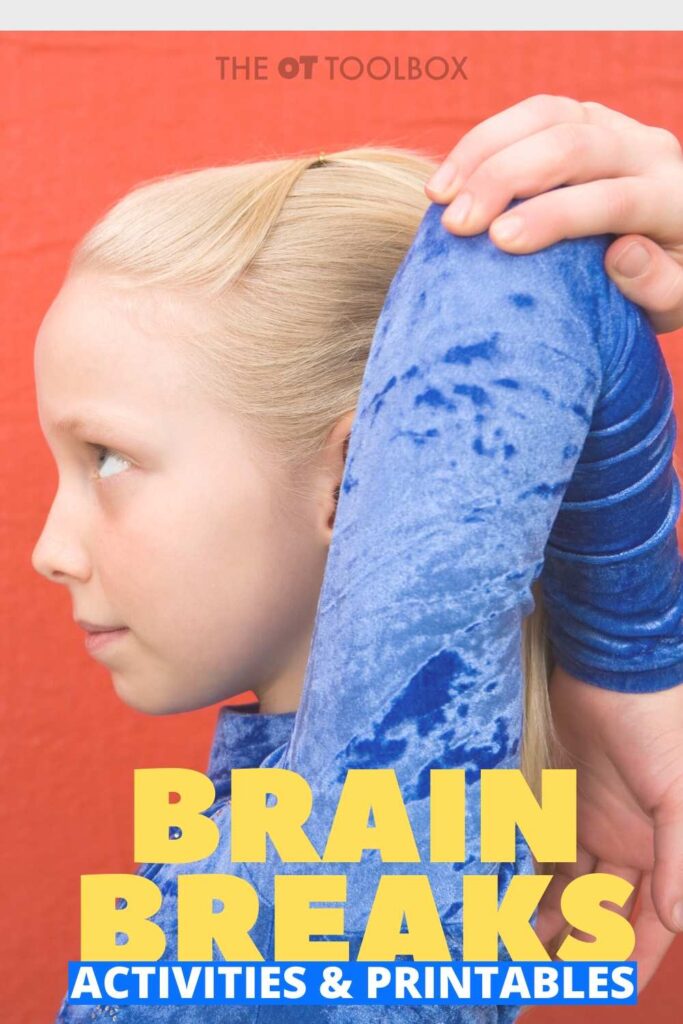
Movement breaks and proprioception
Brain breaks often incorporate heavy work activities, or proprioception.
The proprioceptive system receives input from the muscles and joints about body position, weight, pressure, stretch, movement and changes in position in space during movement, at rest, and during activity.
When we move, the body is able to grade and coordinate movements based on the way muscles move, stretch, and contract during activity.
Proprioception refers to the amount of less pressure and force the muscles and joints exert in a task. In a movement activity, we are able to coordinate our movements effectively to follow a movement pattern.
Examples of heavy work brain and movement activities include:
- Animal walks
- Wall Push-ups
- Chair push-ups
- Traditional push-ups
- Carrying a heavy load like a stack of books or laundry basket
Proprioception breaks occurs with Simon Says activities, when following a brain break YouTube video, or when following a movement exercise card.
Along with these examples, you can get tons of ideas for proprioception activities here. These are great ways to add heavy work to the classroom, home, or therapy clinic.
Movement Breaks and Vestibular Sensory System
The brain also must coordinate input about gravity, movement, and balance involving the vestibular system. Vestibular activities or movement activities are those that offer movement through various planes.
Movement that stimulates the vestibular system utilizes receptors in the inner ear when changes occur in position in space. With the addition of input from the eyes, and feedback from muscle and joint receptors (proprioception), we are able to move through space.
Vestibular sensory input is a huge component of brain breaks.
Movement can be calming or alerting and when it comes to brain break activity, these are the key goals. We may want to calm an unfocused classroom so they can attend and focus in learning. Or we may want to “wake up” a class of fatigued and drowsy students.
Adding a few vestibular activities can have a big impact on attention and focus.
Movement activates the vestibular system and the vestibular system allows movement and participation in tasks.
Vestibular brain and body activity can include breaks such as:
- Dance
- Simon Says
- Spinning
- Kneeling on your knees
- Crawling
- Walking on your tiptoes
- Doing somersaults
- Navigating monkey bars
- Bouncing on a trampoline
Vision and Brain Movement Activity
A final piece of the brain break puzzle is the vision system. To motor plan and complete a movement, in most cases, we need to move in our space. Activities like moving heavy items, completing jumping jacks, following a dance movement, or navigating our space requires some aspect of the visual system.
Specifically is visual motor integration.
Visual Motor Integration- This combination of movement and visual information refers to several areas: including visual perception, visual processing skills, and eye-hand coordination.
The integration of these areas enables the eyes to perceive information through the vision functions so that one can process visual information information in order to perform coordinated hand (and body) motor actions. This integration results with motor task completion.
Visual motor integration includes a perceptual component that allows one to move through space and offer the necessary amount of force to complete movements in the area we are in.
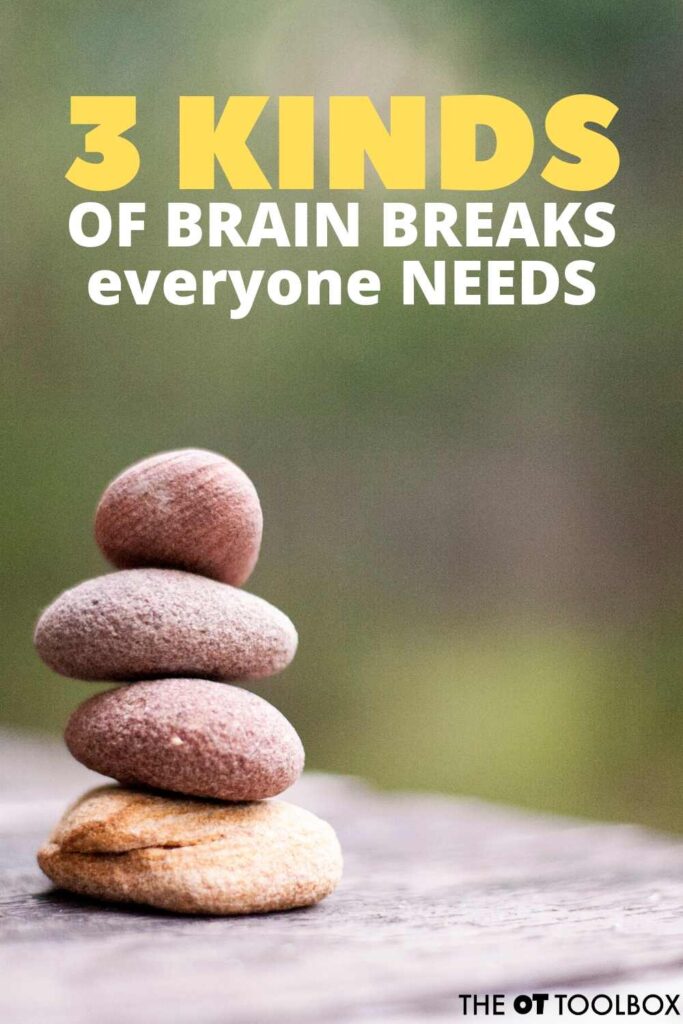
Types of Brain Breaks
Weslake and Christian describes three types of break activities in their paper, “Brain breaks: Help or hindrance?” Those types of brain breaks include:
- Physical brain breaks
- Breathing brain breaks
- Mental brain breaks
Each of these activity breaks are ones that you’ve probably subconsciously incorporated into your day to day activities.
A quick stretch of the arms…a walk to the water fountain during a hectic work day…a phone call to a friend when stressed about a big decision. Kids can incorporate mental and physical gear shifts too!
Physical Brain Breaks- include physical and sometimes vigorous movement activity. These activities might include Yoga, jumping jacks, running in place, dancing, or other motor tasks. These types of physical breaks can promote increased cardiovascular capabilities and increased oxygen like described above, making them a great tool in learning.
Breathing Brain Breaks- These exercises include deep breathing and visualization. These types of breathing breaks can be great for mental health, including as a mental break that allows for the student to ‘re-group” and re-center themselves in the task at hand. Breathing activities might include gentle stretches, rolling the neck, or raising the arms above the head, or shaking out the hands when standing.
Mental Brain Breaks- These mental breaks involve a break from a task requiring a lot of concentration and “switching gears” to a low concentration type of task, such as playing a game, answering trivia questions, or telling jokes.
All of these types of breaks add to learning by way of providing a quick focus change and a means to address needed breaks during periods of high concentration.
Using a variety of brain break activities may be the most beneficial, however, it depends on the make-up of the class as a whole when it comes to classroom breaks between activities.
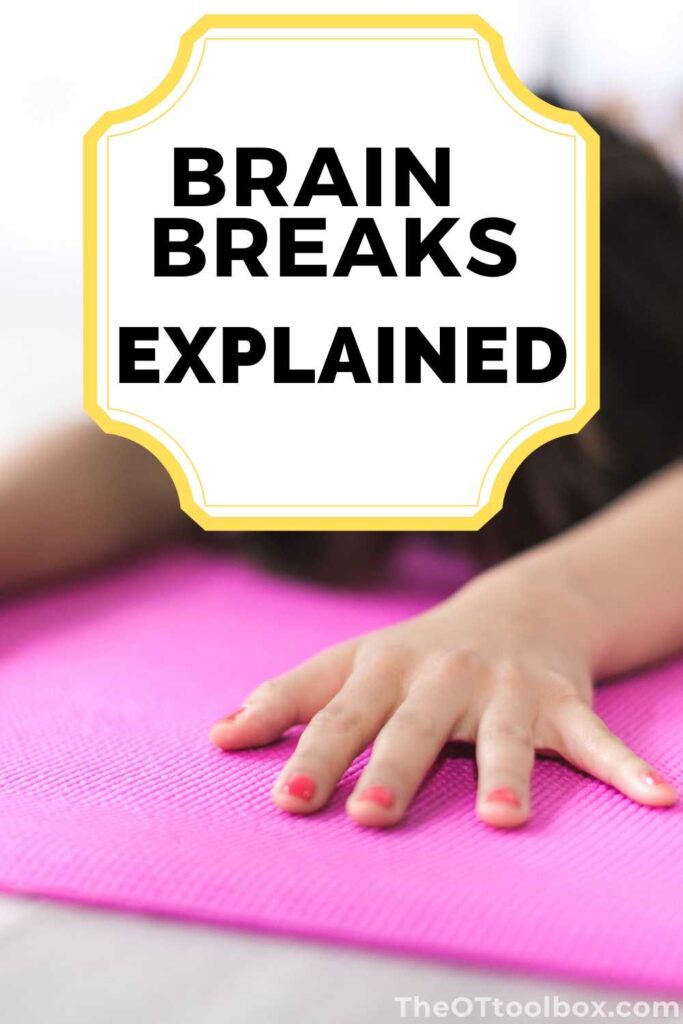
Brain Break Activities for Kids
Try some of these brain break activities to inspire movement, regulation, attention, and concentration, listed below. Some of the printable pages are available as free downloads that you can add to your therapy toolbox.
The nice thing is that you can use brain breaks as an inexpensive calm down strategy at school. This is a great addition to a sensory room on a budget or a calm down corner in the classroom setting.
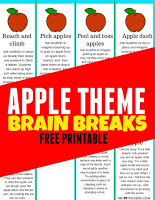
Apple brain breaks can fit into a Fall theme, cooking with kids tasks, or lessons about trees, fruit, or colors. Use these brain break activities with an apple theme to add a little movement to the learning.
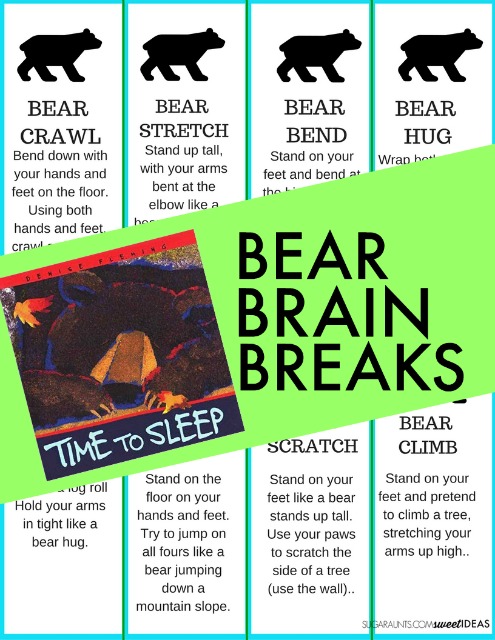
These Bear Brain Breaks are a fun way to get kids moving and grooving with heavy work, for a sensory experience that can calm or provide a much needed movement task. These brain break activities go perfectly with a popular bear children’s book, but can be used in other learning activities, too.
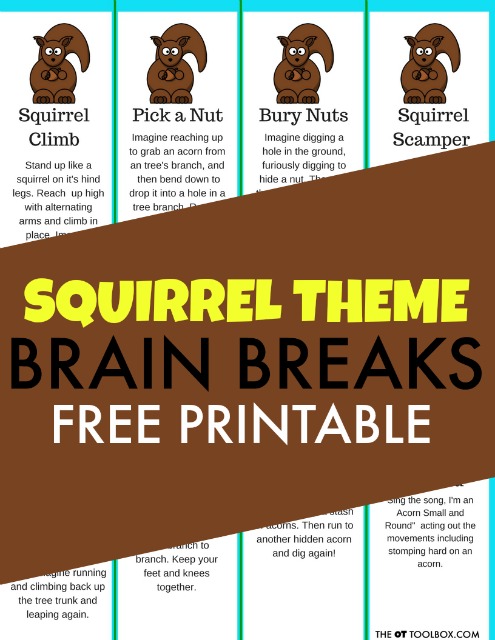
These Squirrel Brain Break Activities were created to align with another popular children’s book, however, you can use them in any way to provide movement and especially vestibular sensory input.
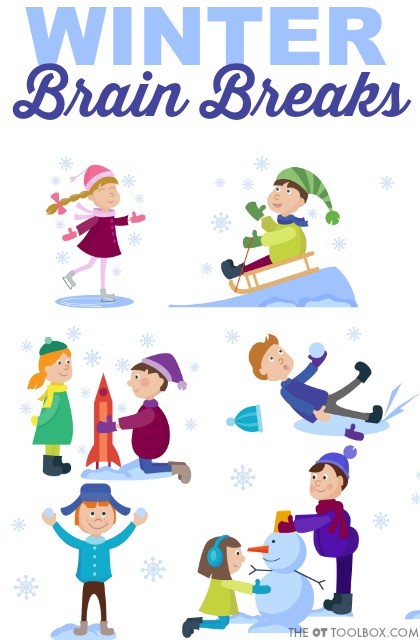
These Winter Brain Breaks are a great addition to the classroom during the winter months, especially if children are not making it outside for recess due to weather. Get the kids moving and playing with these motor activities to add movement to the classroom or home.
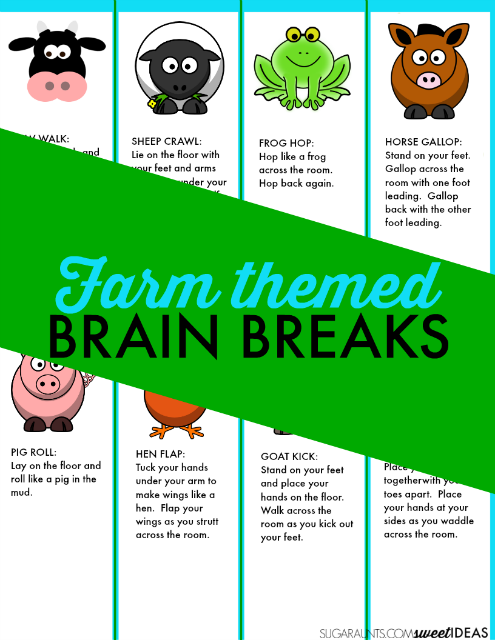
These Farm Brain Breaks were created to go along with the children’s book, Little Blue Truck, but they have a variety of animals so they can be used in different ways, too. Get the kids doing animal walks for movement and activity.
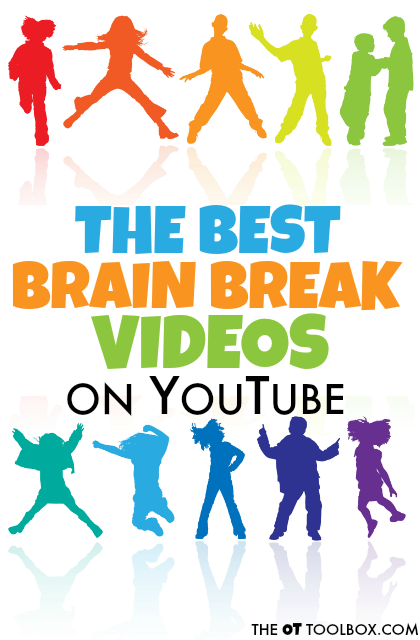
These brain break videos on YouTube make classroom-wide movement activities easy. Use them during transition periods, between activities, for indoor recess, or as an added movement activity right in the classroom or at home.
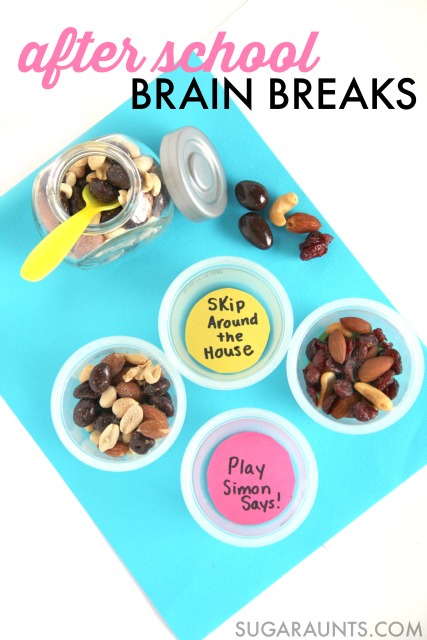
The school day can be challenging for a variety of reasons. These after-school movement breaks use alerting and calming snacks, movement, and connection activities to refresh and recoup after a long day at school.
List of Brain Break Ideas
First, check out this list of movement breaks in the classroom for school-based brain breaks. Remember that adding propriceptive input or vestibular input, and visual input, as well as a combination of these sensory systems.
Seated Brain Break Ideas
Remember also that postural changes adds sensory input to all three of these sensory systems. Changing postures can offer a brain break opportunity even without equipment. You’ll find more ideas listed in our resource on flexible seating ideas and our resource on DIY flexible seating.
Many board games offer a seated movement activity to help kids refocus. Use some of these brain break games to get you started (you’ll find standing and heavy work games listed, too!)
Other seated brain break ideas include:
- Laying on the floor on belly
- Sitting cross legged (crisscross apple sauce)
- Using a sensory cushion
- Kneeling at a table
- Sitting on a stool
- Straddle sitting (with back of chair turned around, child rests chest on chair
- back)
- Add foot support- Add a book or block under feet to be grounded.
- Sit on a therapy ball sitting
- Working on a vertical surface (easel, chalk board, Smartboard, bulletin board, wall)
- Sitting on a partially inflated beach ball
- Asymmetrical sitting position
- Crossword puzzles
- Reading while wrapped up tightly in a blanket- Read our blog post on a burrito blanket to get started.
- Watching a movie under a weighted blanket (appropriately fitted to the individual)
Standing brain break ideas
These ideas can be integrated into the classroom or at home while completing tasks in a standing position.
- Standing breaks- use a timer or an app for reminders (Apple watches offer this reminder option)
- Use a standing desk that raises and lowers
- Or add something under a laptop or writing space to raise the surface for standing
- Take a break and go for a walk
- Do a wall sit for a short time
- Cross crawl exercises
Can routines be adjusted to impact and prevent this period of difficulty? Perhaps a granola bar or apple could be offered just prior to that period. Can you add a short walk around the classroom to gather materials or a walk through the home to pick up clutter that adds movement before a difficult time. It may be something as simple as stretching or getting a cool glass of water.
Consider self-regulation.
Self-regulation needs are greatly impacted by movement breaks. Taking a look at some of the strategies listed in that blog post, you’ll see that most are centered on movement!
To finish out this resource, let’s get you a huge list of brain breaks!
- Animal walks
- Yoga
- Nature walk
- Movement
- Heavy work (Try these themed heavy work activity cards)
- Running, walking
- Deep breaths (try these themed deep breathing cards)
- Listening to music
- Talking to someone
- Activities listed under the other areas
- Stretching
- List out accomplishments
- Help someone
- Reach out to a friend
- Activities listed under the other areas
- Talk to someone
- Rest
- Build a puzzle
- Read a book
- Color or draw
- Think about positive mindset strategies
- Enjoy nature
- Drink a glass of water
- Listen to music
- Write in a journal
- Activities listed under the other areas
PUSHING Brain Breaks
- Chair push ups
- Wall push ups
- Push a large therapy ball or medicine ball along the floor and up the wall as high as you can go
- Pushing a box across the room – fill a box with books or toys and kneel in front of it. Push the box across the room.
- Push a cart full of books
- Fill a laundry basket with laundry and ask your child to push it through the house.
- Push a wheelbarrow or trolley
PULLING Brain Breaks
- Take laundry out of the washer or dryer
- Pull a wagon
- Pulling on a rope – tie a rope to a tree, pole or secure door handle. Hold the rope and see how far you can lean back while pulling on the rope. You only need one person for this tug-of-war game!
- Tug of war – if two or more children are available have a game of tug of war
- Pull up bar – it may be tricky for children to perform pull ups but just hanging from a bar is great work for muscles.
- Pulling and stretching a piece of theraband or stretchy material.
JUMPING Brain Breaks
- Trampoline – this provides endless hours of heavy work activity. Wonderful proprioceptive input while children enjoy the pleasure of jumping.
- Jumping on a mattress on the floor or couch cushions placed on the floor.
- Rocket jumps – crouch down and place your hands on the floor next to you. Count down from ten and leap into the air raising both hands up to the sky. Repeat the rocket launch a few times.
- Star jumps / jumping jacks are great for co-ordination and heavy work.
- Sitting on a small therapy ball and bouncing up and down.
- Hopper balls with handles are also a fun way to bounce around.
LIFTING Brain Breaks
- Carry a stack of books
- Lift and move chairs to sweep
- Lift laundry baskets
- Carrying bags – allow children opportunities to carry bags of groceries or laundry at home
- Weighted backpack – place a few magazines in a backpack and encourage your child to walk around with the backpack for a few minutes.
- A message could be placed in the backpack and your child could deliver this message to a family member at home or to another teacher at school.
- Carry a stack of books
- Carry a full tote bag
- Weighted stuffed animal
CHEWING AND SUCKING Brain Breaks
- Fruit leather
- Sports water bottle
- Chew gum, dried mango, or other dry fruit
- Drink think liquids through a straw e.g. yogurt, thick milkshake
- Specially designed necklaces, bracelets and toys are available for chewing.
- Chew on a straw
- Blow through a straw
- Eat crunchy snacks
- Drink a smoothie through a sippy cup with a straw-type top
- Use a “crazy straw” in a cup. The smaller opening is great for oral motor input.
- Play “Simon Says” with mouth exercises: Suck cheeks in/puff cheeks out/Make a big “O” shape/Stretch out the tongue
- Chew gum
- Use a straw to suck and pick up pieces of paper. Transfer them carefully to a cup using only the straw.
Movement Breaks
Movement breaks look different at different stages of development.
For age-specific brain breaks ideas, try these middle school brain breaks for older students and our resource on brain breaks for high school.
After school is a common time for movement needs. After a long day sitting at a desk, children come home and often decompress. This can look like anger, frustration, and behaviors. While the behavior may seem inappropriate, the actions are often times a needed response to self-regulate based on the long day of holding it together while at school.
Some students may benefit from an after school brain break in the form of regulating snacks or decompression for a short period. Others may require fidget tools during homework. Each individual will be different!
Even as busy therapy providers, we need the power of self-care strategies. Something as simples as simple as taking a quick walk between clients, using relaxation breathing, or stretching can be a huge help
These are resources for self-reflection, mindfulness, self-care strategies, and easy ways to include movement breaks.
Many research studies have discussed the use of both brain breaks and movement breaks in an integrated manner in our daily routines as a tool for attention, mental health, cognitive function, stress management, and well-being.
For example, a study (Maher, et.al, 2006) found that the use of a brain break program in the classroom led to increased on-task behavior and academic achievement These findings suggest that “brain breaks,” can be an effective way to enhance physical activity and cognitive performance in children.
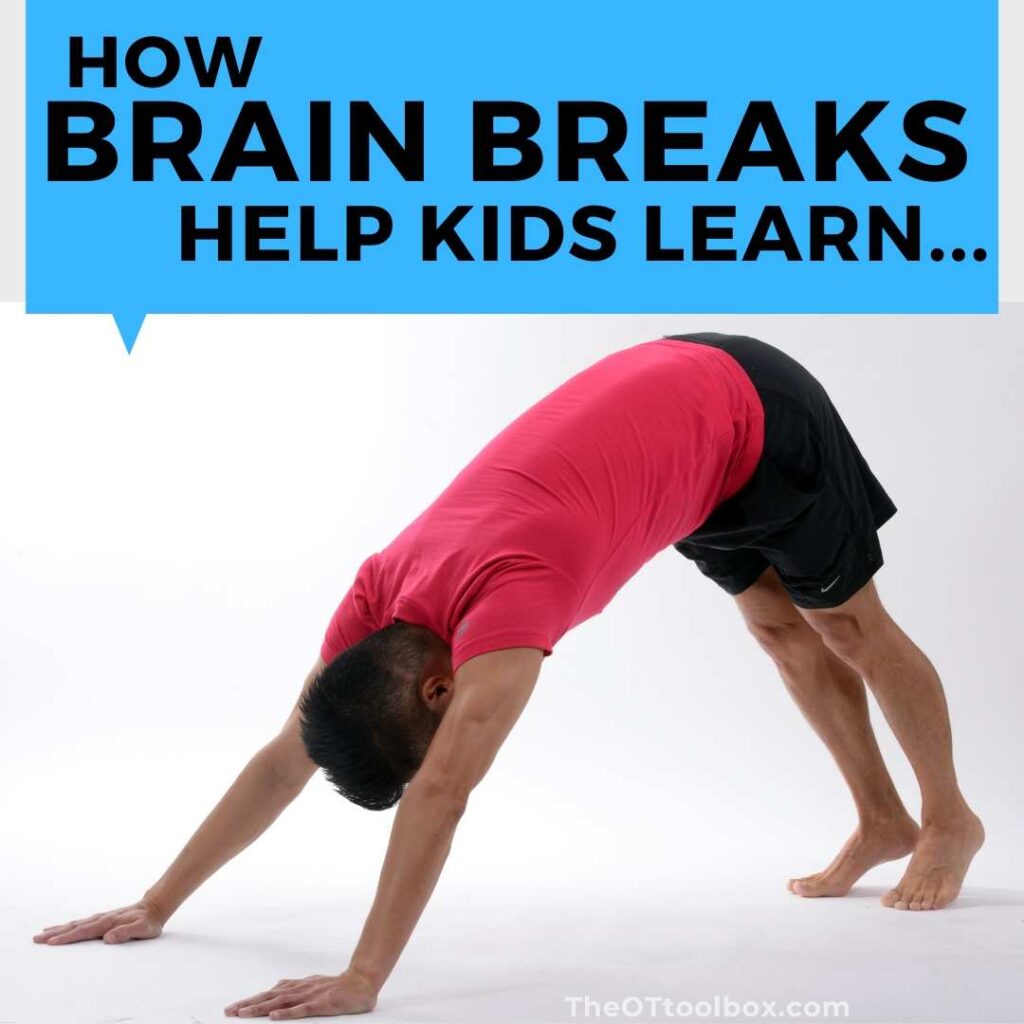
Final thoughts on Movement breaks
Any child (and adult) benefits from an activity break during periods of high concentration and learning. Use these strategies along with your child, or use one of the three types of movement breaks we talked about today!
Think about the time of day that is typically the most difficult. Is there some way that brain breaks can be added to this time? Schedule it in!
References:
Marzano, R. J. (2012). A Moving Proposal. Educational Leadership, 69(7), 88.
Mahar MT, Murphy SK, Rowe DA, et al. Effects of a classroom-based program on physical activity and on-task behavior. Med Sci Sports Exerc. 2006;38(12):2086-2094. doi:10.1249/01.mss.0000235359.16685.a6
Weslake, Alyssa and Christian, Beverly J. (2015) “Brain Breaks: Help or Hindrance?,” TEACH COLLECTION of Christian Education: Vol. 1: Iss. 1, Article 4. Available at: http://research.avondale.edu.au/teachcollection/vol1/iss1/4


